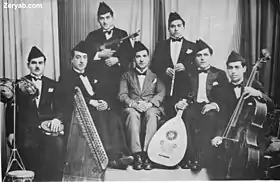Iraqi maqam
Iraqi Maqam (Arabic: المقام العراقي) is a genre of Arabic maqam music found in Iraq. The roots of modern Iraqi maqam can be traced as far back as the Abbasid Caliphate, when that large empire was controlled from Baghdad. The ensemble of instruments used in this genre, called Al Chalghi al Baghdadi, includes a qari' (singer), santur, goblet drum, joza, cello, and sometimes oud and naqqarat. The focus is on the poem sung in classical Arabic or an Iraqi dialect (then called zuhayri). A complete maqam concert is known as fasl (plural fusul) and is named after the first maqam: Bayat, Hijaz, Rast, Nawa, or Husayni.[1]
| Iraqi Maqam | |
|---|---|
 Iraqi maqam performers (Chalgi) led by Yusuf Za'arur. Early 20th century | |
| Country | Iraq |
| Reference | 076 |
| Region | Asia |
| Inscription history | |
| Inscription | 2008 (3rd session) |
A typical performance includes the following sections:[1]
- tahrir, sometimes badwah
- taslum
- finalis
Maqama texts are often derived from classical Arabic poetry, such as by al-Mutanabbi, Jawahiri, al-Mutanabbi and Abu Nuwas. Some performers used traditional sources translated into the dialect of Baghdad, and still others use Arabic, Turkish, Armenian, Hebrew, Turkmen, Aramaic or Persian language lyrics. Due to Iraq's to diversity, different ethnic groups use this genre in their own language.
Famous maqam singers
There are many Iraqi maqam singers including:
| Maqam | |
|---|---|
| Stylistic origins | Middle Eastern musical traditions |
| Cultural origins | ca. 7th–9th century |
| Typical instruments | Santur, joza, bağlama, cello, ney, oud and naqqarat (sometimes) |
| Subgenres | |
| Qubanchi and qundarchi | |
| Fusion genres | |
| Symphonic rock maqam | |
- Ahmed al-Zaidan
- Rashid al-Qundarchi
- Muhammad al-Qubanchi
- Hussein al-A'dhami
- Najm al-Shaykhli
- Hassan Khaiwka
- Hashim al-Rejab
- Yousuf Omar
- Farida Mohammad Ali
- Abd al-Rahman Khader
- Hamed al-Sa‘di
- Nazem Al-Ghazali
- Filfel Gourgy
- Affifa Iskandar
- Mulla Hasan al-Babujachi
- Rahmat Allah Shiltagh
- Khalil Rabbaz
- Rahmain Niftar
- Rubin Rajwan
- Mulla Uthman al-Mawsili
- Jamil al-Baghdadi
- Salman Moshe
- Yusuf Huresh
- Abbas Kambir
- Farida al-A‘dhami
See also
External links
References
- Touma, Habib Hassan (2006). The Music of the Arabs. United States of America: Amadeus Press. pp. 55–57. ISBN 978-1574670813.

